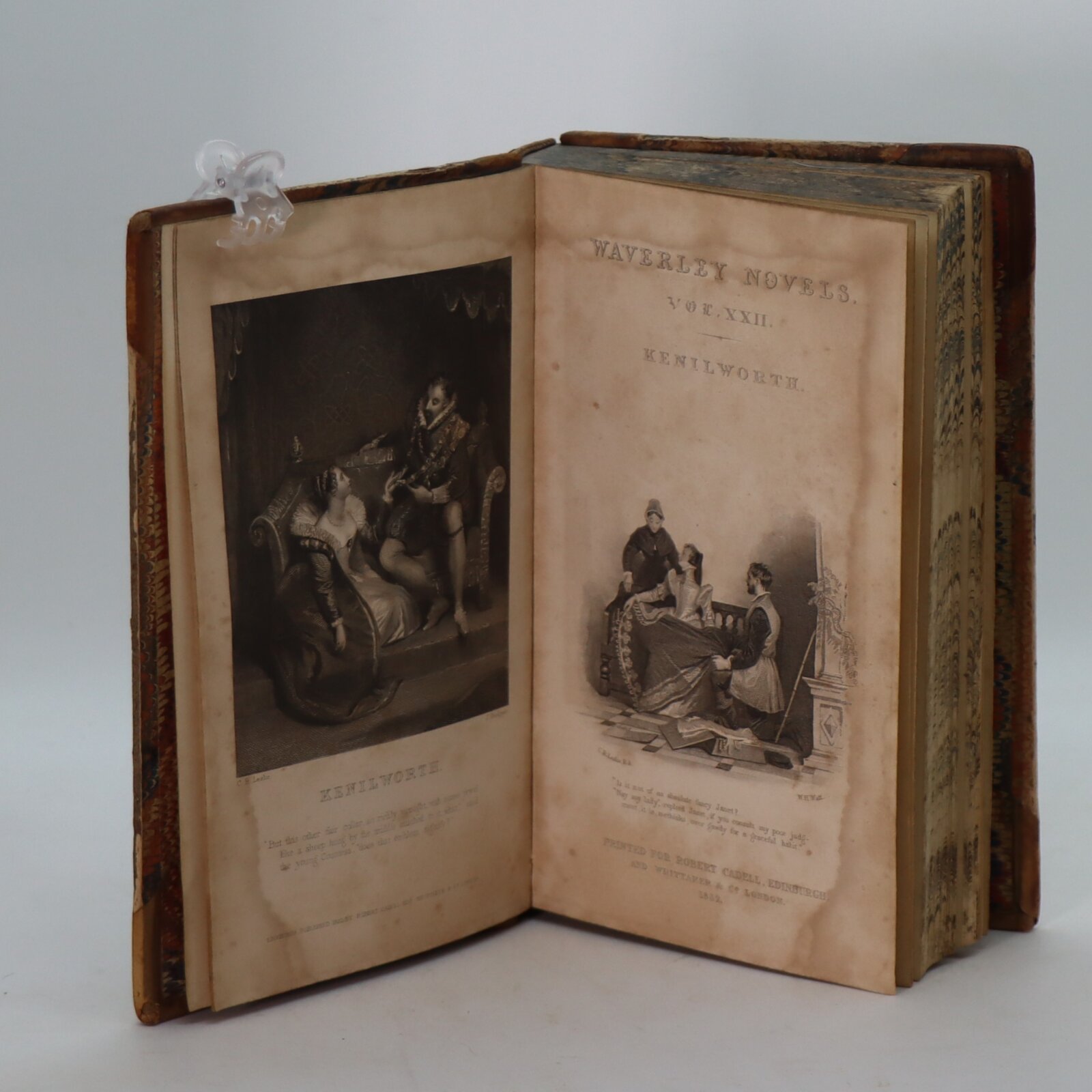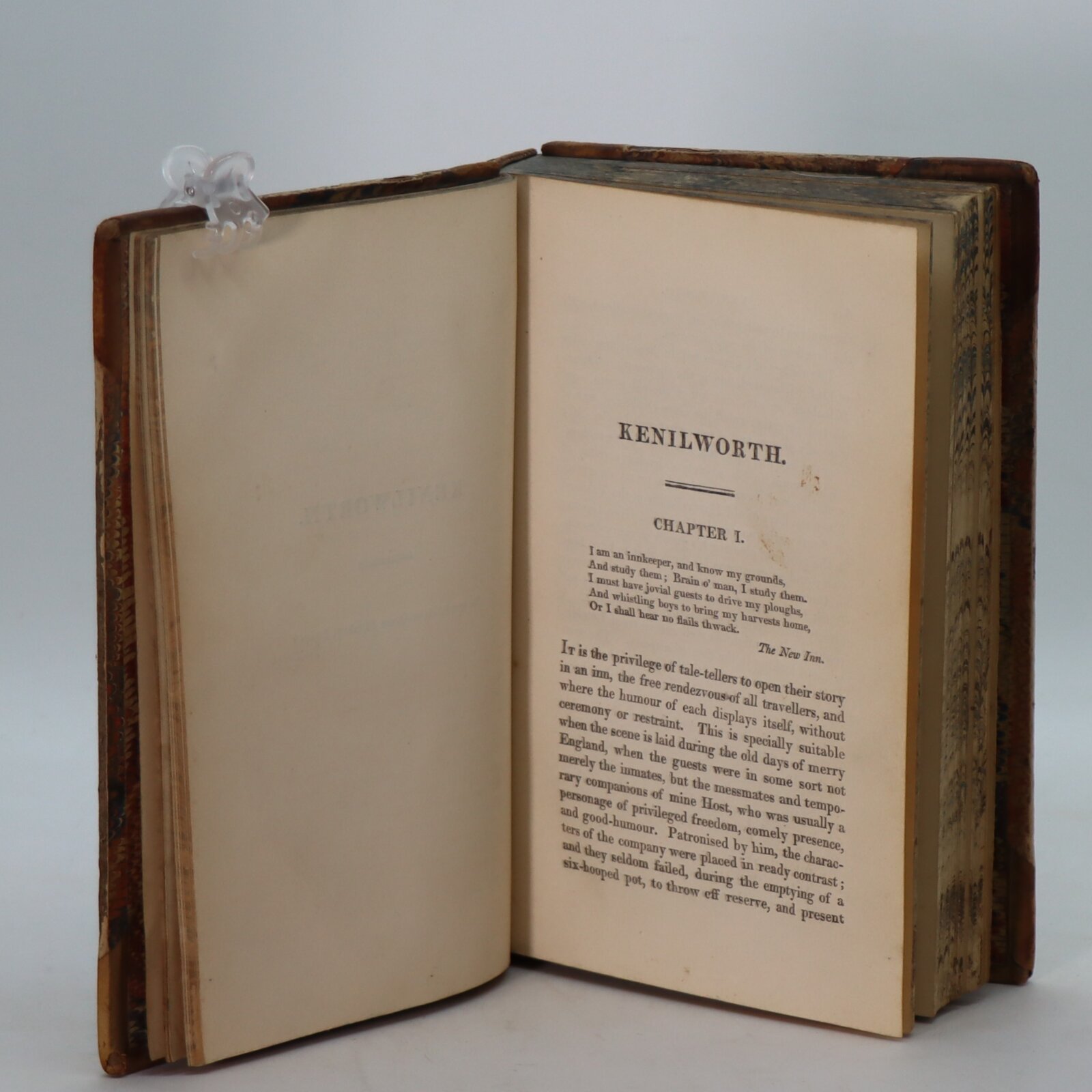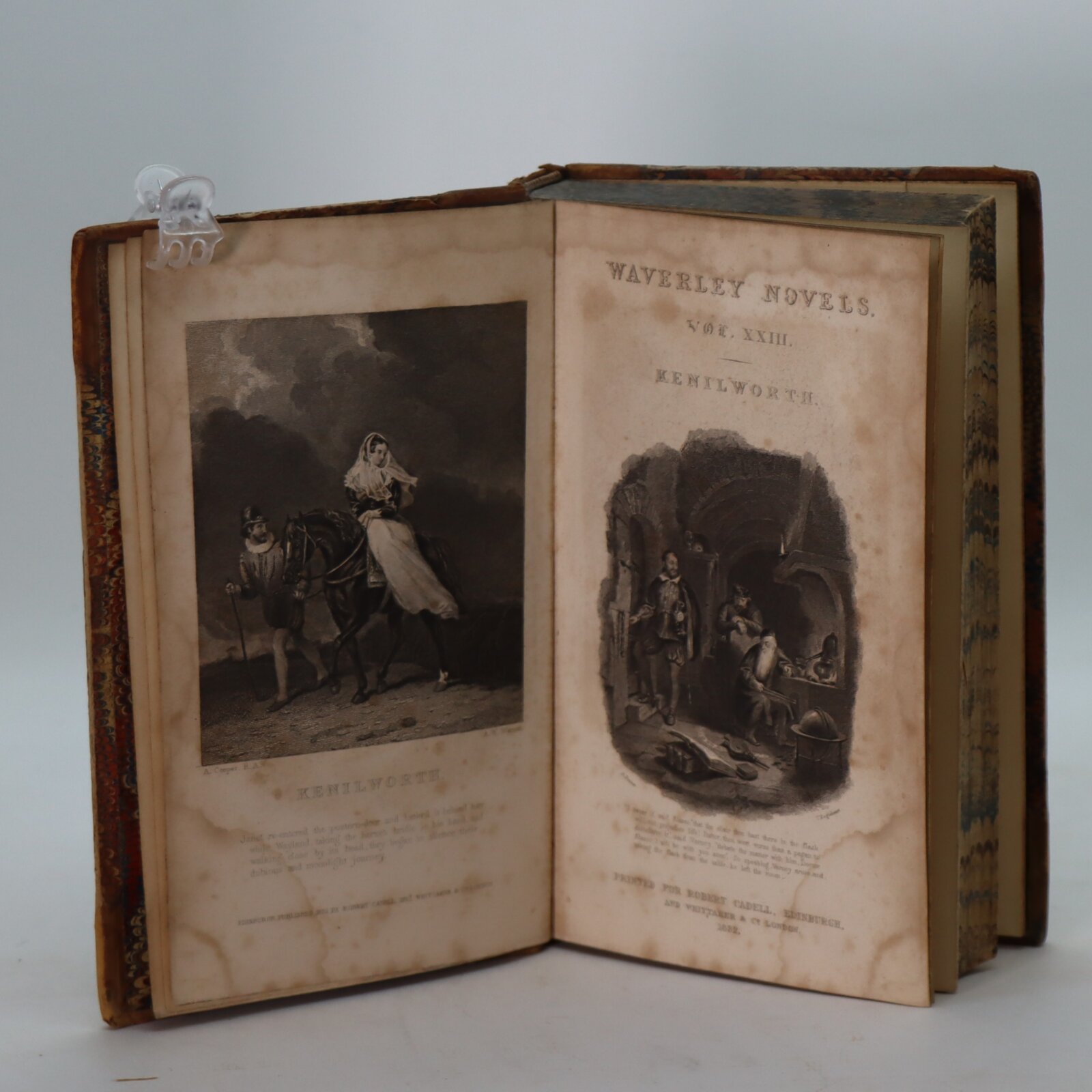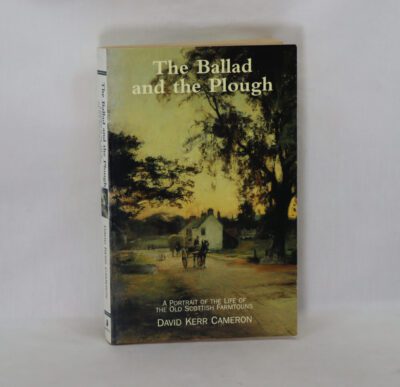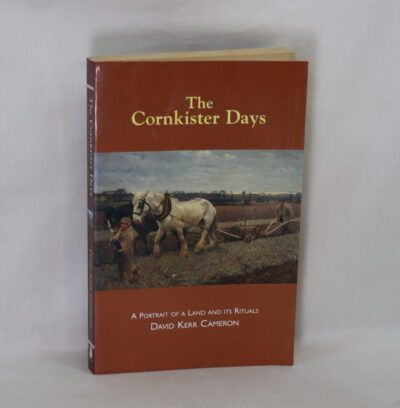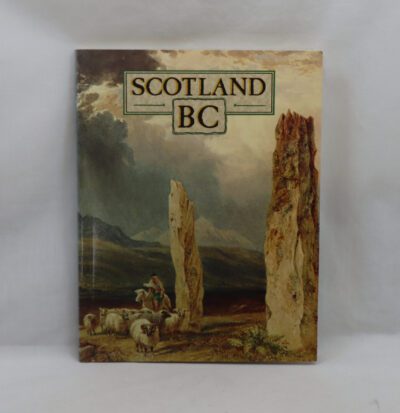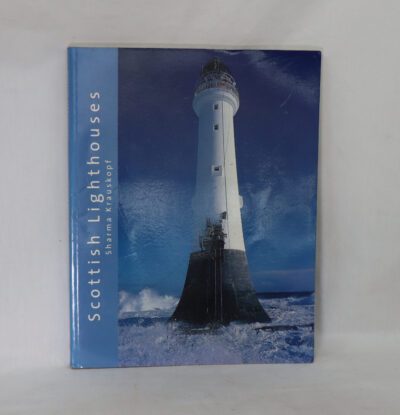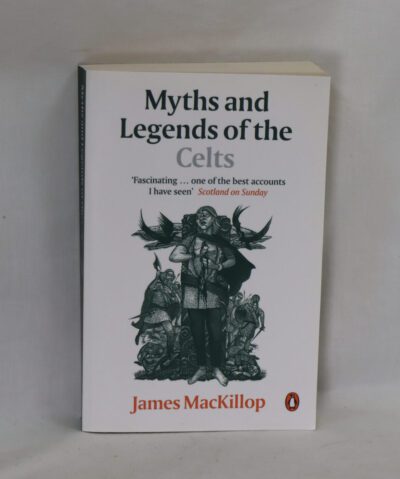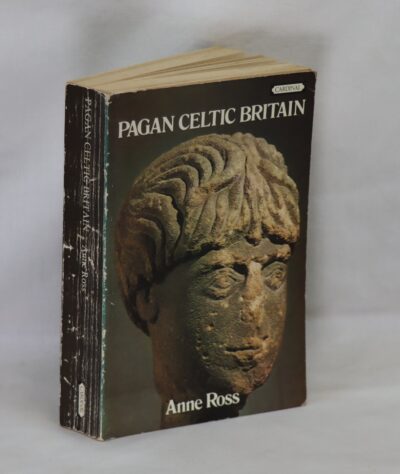Scott's Novels. Kenilworth. Two Volumes.
By Sir Walter Scott
Printed: 1832
Publisher: Robert Caddell. Edinburgh
| Dimensions | 11 × 17 × 3 cm |
|---|---|
| Language |
Language: English
Size (cminches): 11 x 17 x 3
Condition: Fine (See explanation of ratings)
Your items
Item information
Description
Tan calf spine with red title plate with gilt lettering and gilt banding and decoration on the spine. Red and blue marbled paper boards. Dimensions are for one volume.
F.B.A. provides an in-depth photographic presentation of this item to stimulate your feel and touch. More traditional book descriptions are immediately available.
These are two very well bound books whose contents due to poor paper have become discoloured hence the price.
Kenilworth. A Romance is a historical romance novel by Sir Walter Scott, one of the Waverley novels, first published on 13 January 1821. Set in 1575, it leads up to the elaborate reception of Queen Elizabeth at Kenilworth Castle by the Earl of Leicester, who is complicit in the murder of his wife Amy Robsart at Cumnor.
Kenilworth was published in three volumes by Constable and Ballantyne in Edinburgh on 13 January 1821, and by Hurst, Robinson, and Co. in London on the 20th. As with all the Waverley novels before 1827 publication was anonymous. The print run was 10,000, with a further 2000 in a second edition which followed two months later, and the price was one and a half guineas (£1 11s 6d or £1.57½). It is unlikely that Scott was involved with the novel again until April and May 1830, when he revised the text and provided an introduction and notes for the ‘Magnum’ edition in which it appeared as Volumes 22 and 23 in March and April 1831.
The standard modern edition, by J. H. Alexander, was published in 1993 as Volume 11 of the Edinburgh Edition of the Waverley Novels: it is based on the first edition with emendations mainly from the manuscript; the Magnum material is included in Volume 25b.
In January 1820 Archibald Constable and John Ballantyne concluded an agreement to act as joint publishers of Kenilworth, but Scott had still to complete The Monastery and write its sequel The Abbot which kept him occupied until August, so that Kenilworth had to wait until September. Writing then progressed steadily, and the new novel was completed on 27 December.
Scott was deeply acquainted with the literature and historical documents of the Elizabethan period, partly because of his editorial labours. In 1808 he produced Memoirs of Robert Cary, Earl of Monmouth … and Fragmenta Regalia … by Sir Robert Naunton, which were to stand him in good stead for his portrayal of Queen Elizabeth in the novel, and in 1810 he revised Robert Dodsley’s The Ancient British Drama which contributed much to the linguistic texture of the novel. For the public activities at Kenilworth he used two documents reprinted in The Progresses and Public Processions … of Queen Elizabeth by John Nichols (1788): A Letter by Robert Langham or Laneham and The Princely Pleasures at the Courte at Kenelwoorth by George Gascoigne. For Amy Robsart and Cumnor he relied on Antiquities of Berkshire by Elias Ashmole which in turn drew on the anonymous and hostile Secret Memoirs of Robert Dudley, Earl of Leicester or Leicester’s Commonwealth.
Kenilworth is set in the reign of Queen Elizabeth I, and centres on the secret marriage of Robert Dudley, 1st Earl of Leicester, and Amy Robsart, daughter of Sir Hugh Robsart. Amy passionately loves her husband, and the Earl loves her in return, but he is driven by ambition. He is courting the Queen’s favour, and only by keeping his marriage to Amy secret can he hope to rise to the height of power that he desires. At the end of the book, the Queen discovers the truth, to the shame of the Earl. The disclosure has come too late, for Amy has been murdered by the Earl’s even more ambitious steward, Varney.
The Plot Summary
Giles Gosling, the innkeeper, had just welcomed his mischievous nephew Michael Lambourne on his return from Flanders. He invited the Cornishman, Tressilian, and other guests to drink with them. Lambourne made a wager he would obtain an introduction to a certain young lady under the steward Foster’s charge at Cumnor Place, seat of the Earl of Leicester, and the Cornish stranger begged permission to accompany him. On arriving there Tressilian found that this lady was his former lady-love, Amy. He would have carried her back to her home, but she refused; and as he was leaving he quarrelled with Richard Varney, the earl’s squire, and might have taken his life had not Lambourne intervened. Amy was soothed in her seclusion by costly presents from the earl, and during his next visit she pleaded that she might inform her father of their marriage, but he was afraid of Elizabeth’s resentment.
Warned by his host against the squire, and having confided to him how Amy had been entrapped, Tressilian left Cumnor by night, and, after several adventures by the way, reached the residence of Sir Hugh Robsart, Amy’s father, to assist him in laying his daughter’s case before the queen. Returning to London, Tressilian’s servant, Wayland Smith, cured the Earl of Sussex of a dangerous illness. On hearing about this from Walter Raleigh, Elizabeth at once set out to visit Leicester’s rival, and it was in this way that Tressilian’s petition, in Amy’s behalf, was handed to her. The queen was agitated to learn of this secret marriage. Varney was accordingly summoned to the royal presence, but he boldly declared that Amy was his wife, and Leicester was restored to the queen’s favour.
Tressilian’s servant then gained access to the secret countess Amy as a pedlar, and, having hinted that Elizabeth would shortly marry the earl, sold her a cure for the heartache, warning her attendant Janet at the same time that there might be an attempt to poison her mistress. Meanwhile, Leicester was preparing to entertain the queen at Kenilworth, where she had commanded that Amy should be introduced to her, and Varney was, accordingly, despatched with a letter begging the countess to appear at the revels pretending to be Varney’s bride. Having indignantly refused to do so, and having recovered from the effects of a cordial which had been prepared for her by the astrologer Alasco, she escaped, with the help of her maid, from Cumnor, and started for Kenilworth, escorted by Wayland Smith.
Travelling thither as brother and sister, they joined a party of mummers, and then, to avoid the crowd of people thronging the principal approaches, proceeded by circuitous by-paths to the castle. Having, with Dickie Sludge’s help, passed into the courtyard, they were shown into a room, where Amy was waiting while her attendant carried a note to the earl, when she was startled by the entrance of Tressilian, whom she entreated not to interfere until after the expiration of twenty-four hours. On entering the park, Elizabeth was received by her favourite attended by a numerous cavalcade bearing waxen torches, and a variety of entertainments followed. During the evening she enquired for Varney’s wife, and was told she was too ill to be present. Tressilian offered to lose his head if within twenty-four hours he did not prove the statement to be false. Nevertheless, the ostensible bridegroom was knighted by the queen.
Receiving no reply to her note, which Wayland had lost, Amy found her way the next morning to a grotto in the gardens, where she was discovered by Elizabeth, who had just told her host that “she must be the wife and mother of England alone.” Falling on her knees the countess besought protection against Varney, who she declared was not her husband, and added that the Earl of Leicester knew all. The earl was instantly summoned to the royal presence, and would have been committed to the Tower, had not Amy recalled her words, when she was consigned to Lord Hunsdon’s care as bereft of her reason, Varney coming forward and pretending that she had just escaped from a special treatment for her madness. Leicester insisted on an interview with her, when she implored him to confess their marriage to Elizabeth, and then, with a broken heart, told him that she would not long darken his brighter prospects. Varney, however, succeeded in persuading him that Amy had acted in connivance with Tressilian, and in obtaining medical sanction for her custody as mentally disordered, asking only for the earl’s signet-ring as his authority. The next day a duel between Tressilian and the earl was interrupted by Dickie, who produced the countess’s note, and, convinced of her innocence, Leicester confessed that she was his wife. With the queen’s permission he at once deputed his rival and Sir Walter Raleigh to proceed to Cumnor, whither he had already despatched Lambourne, to stay his squire’s further proceedings.
Varney, however, had shot the messenger on receiving his instructions, and had caused Amy to be conducted by Foster to an apartment reached by a long flight of stairs and a narrow wooden bridge. The following evening the tread of a horse was heard in the courtyard, and a whistle like the earl’s signal, upon which she rushed from the room, and the instant she stepped on the bridge, it parted in the middle, and she fell to her death. Her murderer poisoned himself, and the skeleton of his accomplice was found, many years afterwards, in a cell where he secreted his money. The news of the countess’s fate put an end to the revels at Kenilworth: Leicester retired for a time from Court, and Sir Hugh Robsart, who died very soon after his daughter, settled his estate on Tressilian. Leicester pressed for an impartial inquiry. Though the jury found that Amy’s death was an accident (concluding that Lady Dudley, staying alone “in a certain chamber”, had fallen down the adjoining stairs, sustaining two head injuries and breaking her neck), it was widely suspected that Leicester had arranged his wife’s death to be able to marry the Queen.
Sir Walter Scott, 1st Baronet FRSE FSAScot (15 August 1771 – 21 September 1832), was a Scottish historical novelist, poet, playwright and historian. Many works remain classics of European and Scottish literature, notably the novels Ivanhoe, Rob Roy, Waverley, Old Mortality, The Heart of Mid-Lothian and The Bride of Lammermoor, and the narrative poems The Lady of the Lake and Marmion. He had a major impact on European and American literature. As an advocate, judge and legal administrator by profession, he combined writing and editing with daily work as Clerk of Session and Sheriff-Depute of Selkirkshire. He was prominent in Edinburgh’s Tory establishment, active in the Highland Society, long a president of the Royal Society of Edinburgh (1820–1832), and a vice president of the Society of Antiquaries of Scotland (1827–1829). His knowledge of history and literary facility equipped him to establish the historical novel genre and as an exemplar of European Romanticism. He became a baronet “of Abbotsford in the County of Roxburgh”, Scotland, on 22 April 1820; the title became extinct on his son’s death in 1847.
Although he continued to be extremely popular and widely read, both at home and abroad, Scott’s critical reputation declined in the last half of the 19th century as serious writers turned from romanticism to realism, and Scott began to be regarded as an author suitable for children. This trend accelerated in the 20th century. For example, in his classic study Aspects of the Novel (1927), E. M. Forster harshly criticized Scott’s clumsy and slapdash writing style, “flat” characters, and thin plots. In contrast, the novels of Scott’s contemporary Jane Austen, once appreciated only by the discerning few (including, as it happened, Scott himself) rose steadily in critical esteem, though Austen, as a female writer, was still faulted for her narrow (“feminine”) choice of subject matter, which, unlike Scott, avoided the grand historical themes traditionally viewed as masculine.
Nevertheless, Scott’s importance as an innovator continued to be recognised. He was acclaimed as the inventor of the genre of the modern historical novel (which others trace to Jane Porter, whose work in the genre predates Scott’s) and the inspiration for enormous numbers of imitators and genre writers both in Britain and on the European continent. In the cultural sphere, Scott’s Waverley novels played a significant part in the movement (begun with James Macpherson’s Ossian cycle) in rehabilitating the public perception of the Scottish Highlands and its culture, which had been formerly been viewed by the southern mind as a barbaric breeding ground of hill bandits, religious fanaticism, and Jacobite risings.
Scott served as chairman of the Royal Society of Edinburgh and was also a member of the Royal Celtic Society. His own contribution to the reinvention of Scottish culture was enormous, even though his re-creations of the customs of the Highlands were fanciful at times. Through the medium of Scott’s novels, the violent religious and political conflicts of the country’s recent past could be seen as belonging to history—which Scott defined, as the subtitle of Waverley (“‘Tis Sixty Years Since”) indicates, as something that happened at least 60 years earlier. His advocacy of objectivity and moderation and his strong repudiation of political violence on either side also had a strong, though unspoken, contemporary resonance in an era when many conservative English speakers lived in mortal fear of a revolution in the French style on British soil. Scott’s orchestration of King George IV’s visit to Scotland, in 1822, was a pivotal event intended to inspire a view of his home country that, in his view, accentuated the positive aspects of the past while allowing the age of quasi-medieval blood-letting to be put to rest, while envisioning a more useful, peaceful future.
After Scott’s work had been essentially unstudied for many decades, a revival of critical interest began in the middle of the 20th century. While F. R. Leavis had disdained Scott, seeing him as a thoroughly bad novelist and a thoroughly bad influence (The Great Tradition [1948]), György Lukács (The Historical Novel [1937, trans. 1962]) and David Daiches (Scott’s Achievement as a Novelist [1951]) offered a Marxian political reading of Scott’s fiction that generated a great deal of genuine interest in his work. These were followed in 1966 by a major thematic analysis covering most of the novels by Francis R. Hart (Scott’s Novels: The Plotting of Historic Survival). Scott has proved particularly responsive to Postmodern approaches, most notably to the concept of the interplay of multiple voices highlighted by Mikhail Bakhtin, as suggested by the title of the volume with selected papers from the Fourth International Scott Conference held in Edinburgh in 1991, Scott in Carnival. Scott is now increasingly recognised not only as the principal inventor of the historical novel and a key figure in the development of Scottish and world literature,
Condition notes
Want to know more about this item?
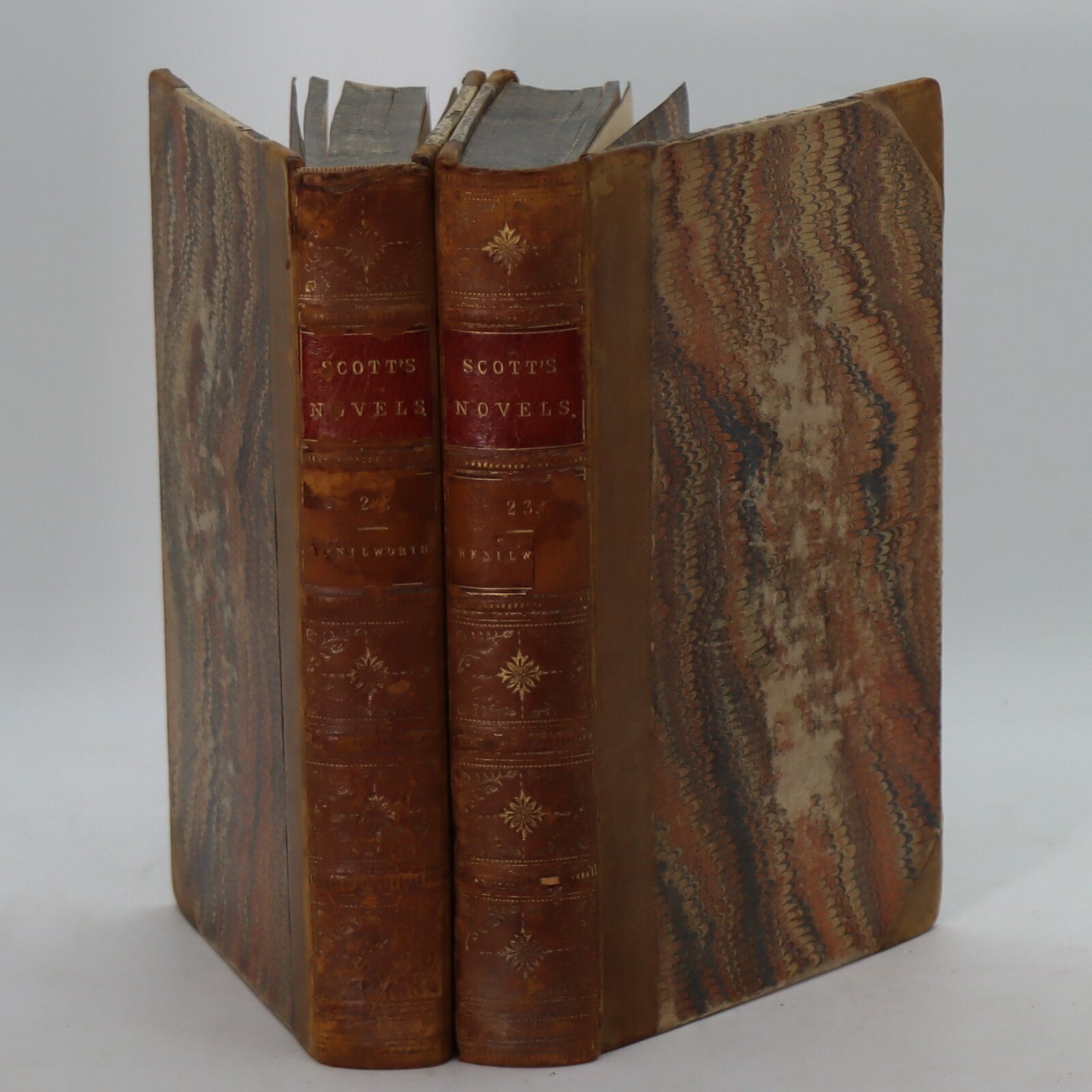
Related products
Share this Page with a friend

